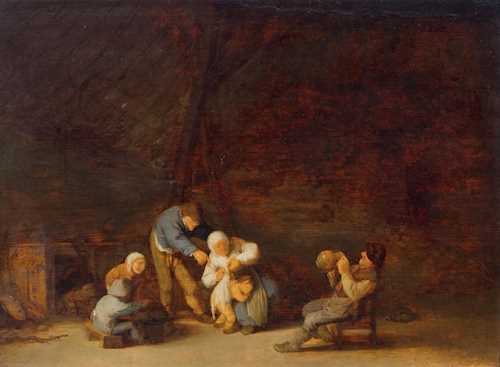
Lot 3035 - A198 Old Master Paintings - Friday, 01. October 2021, 02.00 PM
ADRIAEN VAN OSTADE
(1610 Haarlem 1685)
Peasants in an interior. 1637.
Oil on panel.
Signed and dated centre left: Av (ligature) ostade 1637.
28 × 38.7 cm.
Certificate:
Dr Bernhard Schnackenburg, 14.11.2019.
Provenance:
- With J. Dik, Vevey, circa 1950.
- Swiss private collection.
Our thanks to Dr. Schnackenburg who has confirmed the authenticity of this painting on the basis of a photograph. He describes "Peasants in an interior" as typical of the work of Adriaen van Ostade.
The painting dates from the period in which the artist worked with rough outlines and brown tones. Thus, the group of figures in the centre of the picture is unerringly executed with outstanding liveliness, and the timberwork of the barn interior is sketched. Dr. Schnackenburg refers to the "The Washerwoman" of 1637 as a well-known comparable work from this stylistic phase, which is in the Hamburg Kunstalle (Inv.-No. HK–122).
As Dr. Schnackenburg states in his report, the depiction of everyday motifs in Dutch painting also had a fundamentally allegorical significance. These works were part of everyday culture and were understood without any explicit references. The peasant woman who inspects the boy’s shirt for fleas, as well as the peasant who stares into his empty beer jug, suggest that this is a representation of the five senses and, namely, the sense of sight (visus).
Dr Bernhard Schnackenburg, 14.11.2019.
Provenance:
- With J. Dik, Vevey, circa 1950.
- Swiss private collection.
Our thanks to Dr. Schnackenburg who has confirmed the authenticity of this painting on the basis of a photograph. He describes "Peasants in an interior" as typical of the work of Adriaen van Ostade.
The painting dates from the period in which the artist worked with rough outlines and brown tones. Thus, the group of figures in the centre of the picture is unerringly executed with outstanding liveliness, and the timberwork of the barn interior is sketched. Dr. Schnackenburg refers to the "The Washerwoman" of 1637 as a well-known comparable work from this stylistic phase, which is in the Hamburg Kunstalle (Inv.-No. HK–122).
As Dr. Schnackenburg states in his report, the depiction of everyday motifs in Dutch painting also had a fundamentally allegorical significance. These works were part of everyday culture and were understood without any explicit references. The peasant woman who inspects the boy’s shirt for fleas, as well as the peasant who stares into his empty beer jug, suggest that this is a representation of the five senses and, namely, the sense of sight (visus).
CHF 10 000 / 15 000 | (€ 10 310 / 15 460)
Sold for CHF 13 720 (including buyer’s premium)
All information is subject to change.

